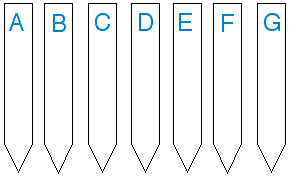Seven pots of plants
Problem
There are seven pots of plants in a greenhouse. They have lost their labels.

Perhaps you can help re-label them.

F and G have wide pots.
C, E and F have just one flower.
B and D have tall pots.
B and E have blue flowers.
Can you do it?
Getting Started
Draw out the pots or use this sheet, colour the flowers and then pencil in the possible letters by the pots.
Student Solutions
Thank you to everyone who sent solutions to this problem. We had many correct answers, but not many of you explained how you worked through the problem. Abigail from Histon and Impington Infant School and Nathaniel who goes to Moorfield Junior School, both did it in the same way. Abigail and Nathaniel numbered the pots from 1 to 7, left to right, to help them answer the question. Nathaniel wrote to us:
First we knew that F and G had a wide pot, and that F had just one flower. So pot three is F and pot five is G.
Then we looked at C and E. We knew that E had one blue flower - so pot two had to be E and pot six had to be C.
We knew that pot B had a tall pot and blue flowers. This had to be pot seven.
D had to be pot one - the other tall pot.
The last pot, pot four, had to be A because it was the only one left.
Matthew, from William Cobbet Junior School, approached the problem slightly differently:
The order of the pots is D, E, F, A, G, C, B.
I knew that B was a tall blue pot and E was the other blue pot.
I knew that C was thin with one flower, so A was a thin pot with two flowers.
D had to be the first one because it was tall but didn't have blue flowers.
G had to have a large pot with two flowers, so that left F to have a large pot with one flower.
Finally, Ruth who goes to Swanbourne House School found yet another way of doing it:
The answer is D E F A G C B.
You can work this out because:
Only E is both blue and has only one flower.
Only F has a wide pot and one flower.
B is the remaining blue flower.
So then D must be the tall pot with yellow flowers and G must be the wide pot with two flowers.
C is the remaining single flower.
Then the last pot is A.
All of these are very clearly described which is exactly what we're looking for! Well done.
